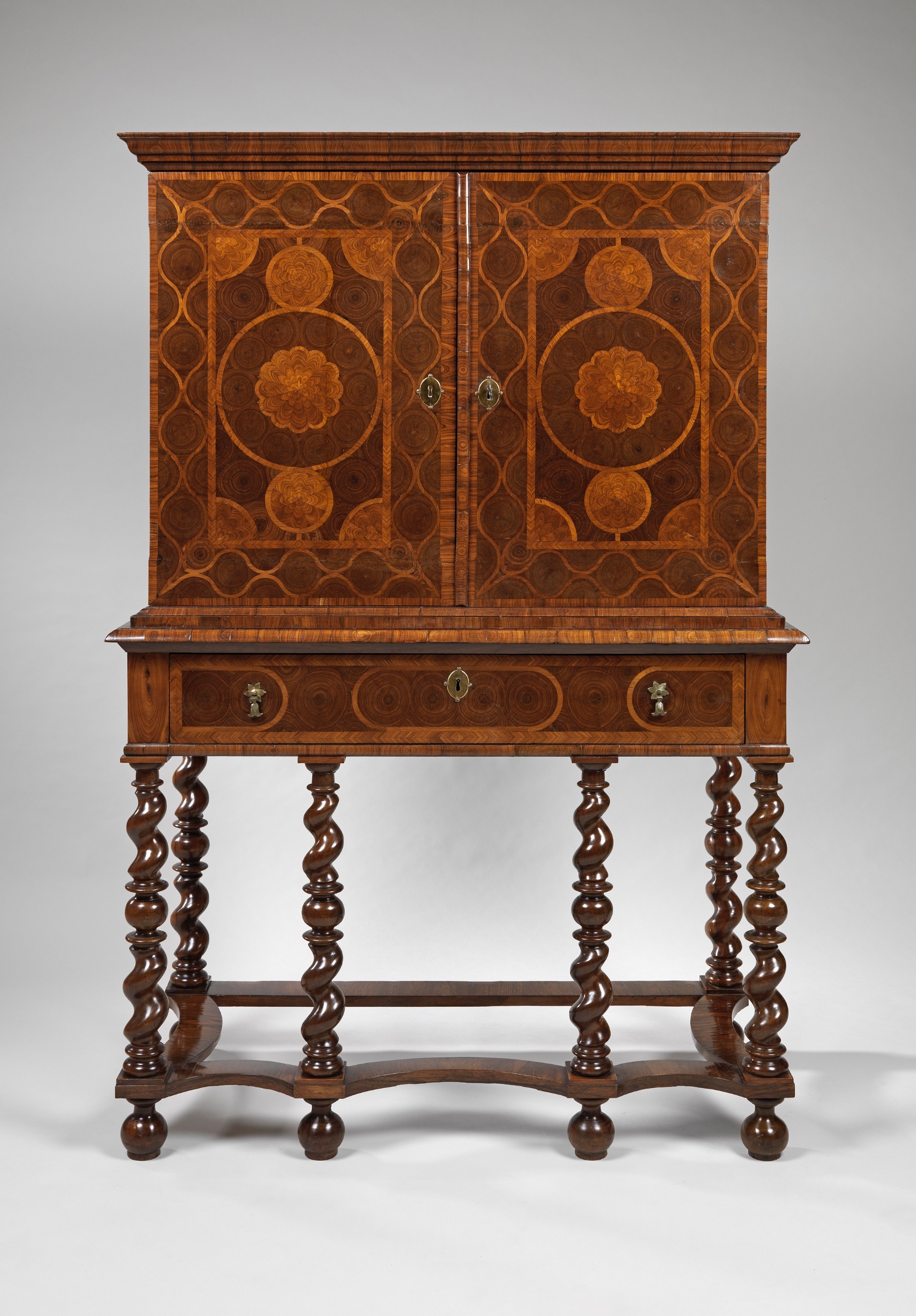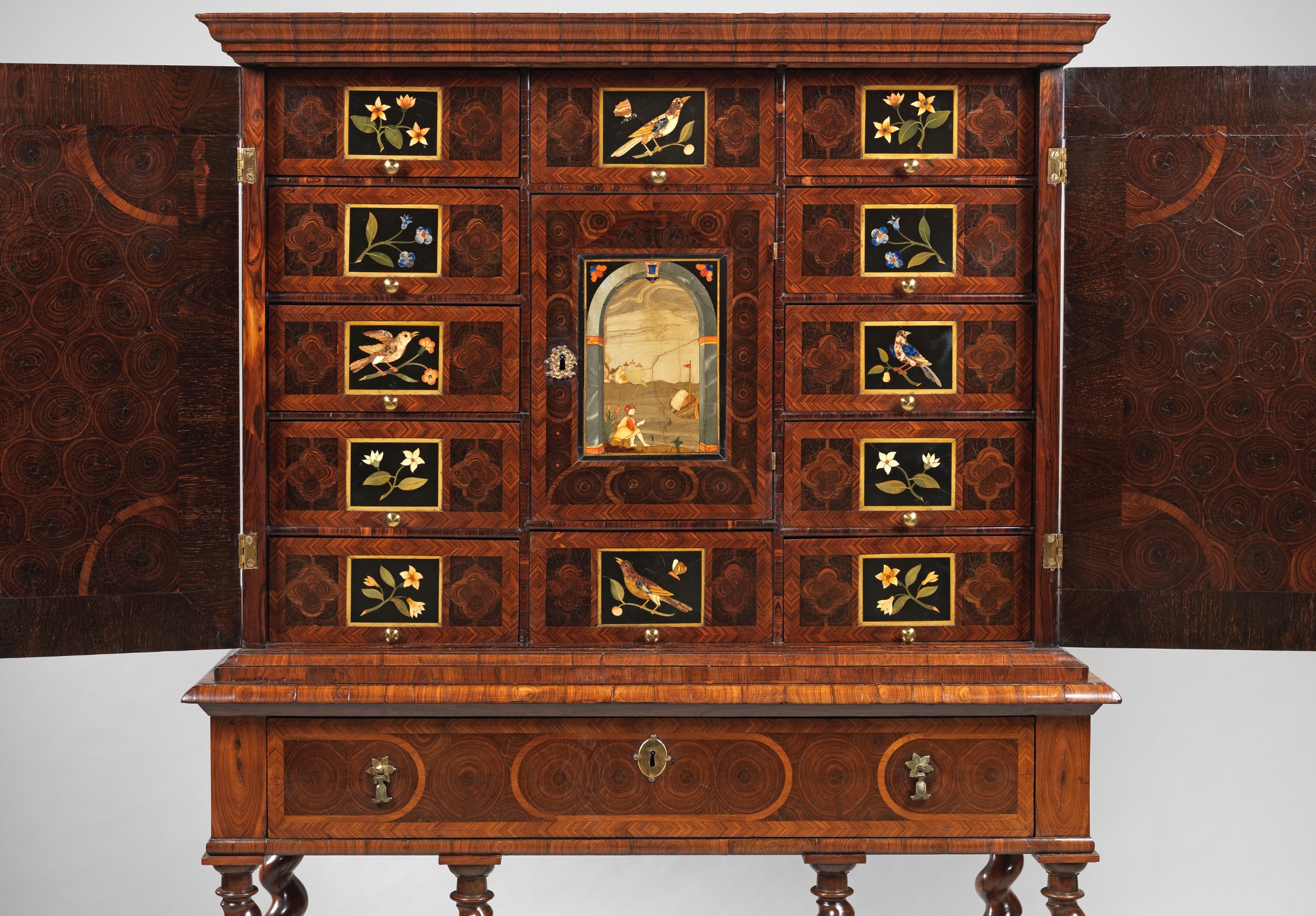

1680


This exceptional cabinet is one of only a handful of known pieces commissioned by English patrons to display panels of Italian pietre dure. The most famous of these is the Badminton cabinet, commissioned by Henry Scudamore, 3rd Duke of Beaufort in 1726. This is now in the Liechtenstein Museum, Vienna, having been acquired in 2004 for a world record price of £19 million ($36.7million). The earliest example is that commissioned by John Evelyn in Paris, using panels bought in Florence in 1644. This cabinet was acquired for the Victoria and Albert Museum in 1977.[i] However, neither the Badminton cabinet nor the Evelyn cabinet were made in England. The present cabinet, by contrast, is wholly English, with the exception of the pietre dure panels, which were made in Italy about the third quarter of the 17th century. Only one comparable example is known, a cabinet of about 1670 which was sold by Mallet in 1947 and again in the 1990s.[ii] That cabinet, however, does not have its original stand and the present cabinet is therefore unique. The only comparable object is the cabinet designed by Robert Adam for the Duchess of Kimbolton and made by the London cabinet-makers Mayhew and Ince about 1771-76.[iii]
The panels
The art of pietre dure, or inlaying in polychrome hardstones, was perfected in Rome and Florence in the late 16th century. Such was the expense of the work that it was initially restricted to commissioned work for individual, very wealthy patrons, but by the early 17th century panels of pietre dure were produced for a wider commercial market. Englishmen first became acquainted with pietre dure during their ‘Grand Tours’ of Italy, and John Evelyn’s account of his purchase in Florence is the earliest known English description of the work, which he called ‘pietra commesso’:
Here we saw diverse tables of Pietra Commesso, which is a marble ground inlaid with several sorts of marbles and stones of various colours, representing flowers, trees, beasts, birds, and landscapes. In one is represented the town of Leghorn, by the same hand who inlaid the altar of St Lawrence, Domenico Benotti, of whom I purchased nineteen pieces of the same work for a cabinet.[iv]
Evelyn’s nineteen panels were made up, either in Florence or Paris, into the cabinet now in the V&A. The panels on the present cabinet are very similar in style and are almost certainly the products of a Florentine workshop, while their size and shape suggests they were specifically designed with a casket or cabinet in mind. The subject matter of birds, flowers, fruit and foliage is typical, as is the central panel, a Roman arch with harbour, shipping and castle beyond.
The cabinet
The design and construction of the cabinet, while conforming to standard English practise, evinces some unusual features which indicate a good deal of forethought and planning by the maker. In order to accommodate the pietre dure, the cabinetmaker has created layered drawer fronts, the panels being planted on and framed with oak slips which were then veneered and feather-banded. This required all the drawers to be made short, so that the addition of the panel brought them flush to the front of the dustboards. In addition, the drawers above and below the central niche have been re-aligned to accept two slightly larger panels while maintaining the same style of featherbanding. Because the panels occupy the centre of the drawer fronts, the usual style of drop-handles has been abandoned in favour of small knobs, mounted towards the bottom edge of the drawer.
Another remarkable feature of the cabinet is the extravagant use of exotic woods. The ‘oyster’ veneers are of princes wood, so called because of its very high price. The modern name is kingwood, and it is obtained from the South American tree Dalbergia cearensis, which is indigenous to north-eastern Brazil and the Guianas. Princes wood furniture was made, as the name suggests, only for the very wealthy, and its use is characteristic of late 17th century English cabinet-making at the highest level. Even more unusual is the use of Brazilian rosewood (Dalbergia nigra) for drawer linings and for the twist-turned pillars of the stand. This wood was difficult to obtain in England at this date and is more typical of high-status French furniture; the similarities with contemporary French work extend to the veneering of the inside fronts of the drawers in the same wood. At the very least this suggests that the maker was acquainted with French cabinet-work of the highest calibre. The use of solid rosewood for the twist-turned pillars and ball feet in the stand accounts very largely for their survival unaffected by worm or rot. Finally, the lighter and narrower sections of crossbanding on the doors and other areas appear to be of padouk (probably Pterocarpus indicus), imported from Asia.
The cabinet-maker
It is tempting to ascribe this cabinet to a well-known cabinet-maker such as Gerrit Jensen (fl. 1667-1714, appointed cabinet-maker to William III and Queen Mary in 1689), but the fact is that there are no comparable examples on which to base such an attribution. There were perhaps half-a-dozen cabinet-makers of this calibre working in London in the 1670s and 1680s - men like John Burroughs, William Farnborough, Thomas Pistor and Edward Traherne.[v] Traherne in particular had a remarkable clientele, including Queen Henrietta Maria, the princesses Mary and Anne, and the Duke of Buckingham, while Farnborough supplied furniture to the Royal Wardrobe for use in the royal palaces in addition to that supplied by Jensen.[vi] Surviving bills reveal that even in at this level, princes wood furniture was not common, and cabinets mounted with pietre dure seemingly unheard of. The commissioning and making of this cabinet was therefore an exceptional event, even among the social élite of post-restoration England.
[i] V&A, W24.1-23-1977.
[ii] Illustrated in Lanto Synge, Mallet Millenium, London (1999), p. 30 and front of dust jacket.
[iii] V&A, W43- 1949.
[iv] Evelyn, Diary, 24 October 1644.
[v] Beard & Gilbert, Dictionary of English Furniture-Makers 1660-1840 (Leeds 1986).
[vi] National Archives, Lord Chamberlain’s accounts (LC9).
| Dimensions | CM | Inches |
|---|---|---|
| Width: | 99 | 39 |
| Depth: | 48 | 19 |
| Height: | 161 | 63 |